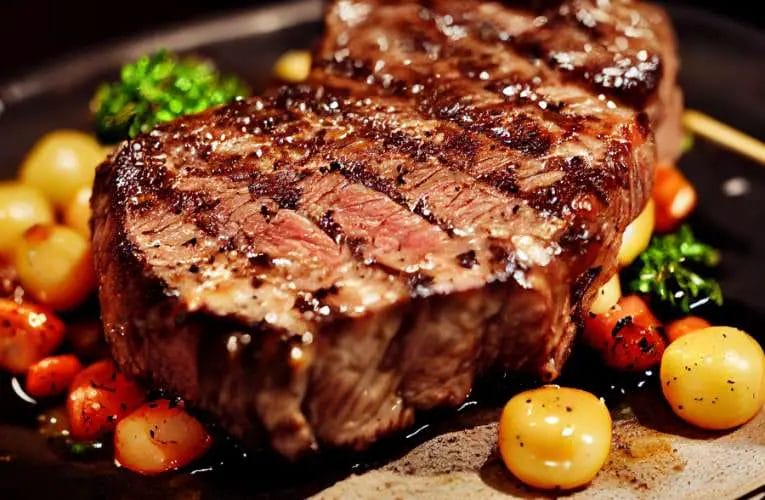If you’ve ever bitten into a steak, expecting a tender and juicy experience, only to be met with tough and chewy meat, you’re not alone. There are a few reasons why your steak may turn out tough, and it can be quite frustrating.
One of the main factors is the quality of the meat itself, with tougher cuts requiring different cooking methods. Another factor to consider is the cooking temperature and duration, as overcooking can lead to a tough texture.
By understanding these factors and making some adjustments, you can elevate your steak game and enjoy a melt-in-your-mouth dining experience.
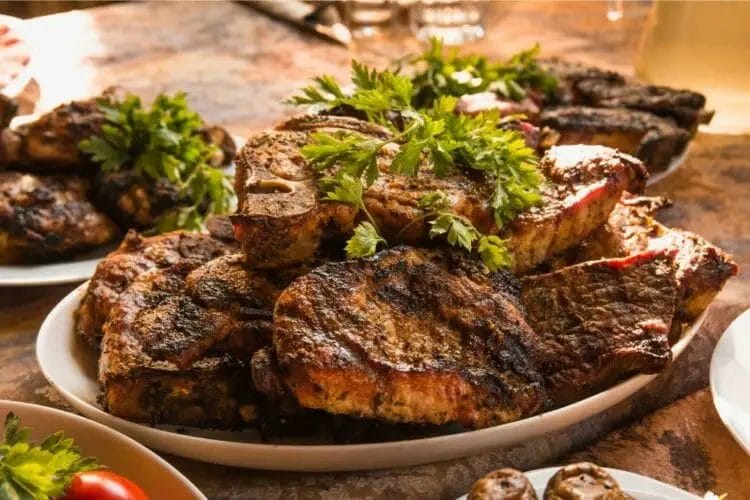
Common Causes of Tough Steak
Steak is a popular choice of meat for many people due to its rich flavor and juicy tenderness. However, there are times when a steak turns out tough and chewy, which can be quite disappointing.
Understanding the common causes of tough steak can help you avoid making the same mistakes and ensure a delicious and tender result every time.
1. Overcooking
One of the main culprits behind tough steak is overcooking. Cooking a steak for too long or at too high of a temperature can cause the meat to become dry and tough. The heat breaks down the proteins in the steak, causing them to become firm and lose moisture.
To prevent overcooking, it’s essential to use a meat thermometer to monitor the internal temperature of the steak. The recommended temperature for a medium-rare steak is around 135°F (57°C).
Remove the steak from the heat source a few degrees below the desired temperature, as it will continue to cook while resting.
2. Low-Quality Meat
The quality of the meat you choose can significantly affect the tenderness of your steak. Lower-quality cuts of beef, such as those from older or less-marbled cows, tend to be tougher. These cuts often have less fat and collagen, which are essential for achieving a tender and juicy steak.
Opting for higher-quality cuts, such as USDA Prime or Choice, can greatly improve the tenderness of your steak. These cuts come from younger and well-marbled cows, which results in more tender and flavorful meat.
3. Lack of Marination
Marinating your steak before cooking can help tenderize the meat and add flavor. Certain ingredients, like acidic liquids (lemon juice, vinegar), enzymes (pineapple, papaya), and tenderizing spices (ginger, garlic), can break down the tough muscle fibers in the meat.
For optimal results, marinate your steak for at least 30 minutes or up to 24 hours, depending on the thickness and cut. Be cautious not to overmarinate as the meat can become mushy or overly seasoned.
4. Improper Slicing
The way you slice your steak can also contribute to its tenderness. Cutting the steak against the grain, or perpendicular to the muscle fibers, helps break them up and results in a more tender texture.
Identify the direction of the muscle fibers and make sure to cut across them when slicing the steak. This technique helps shorten the muscle fibers, making the meat easier to chew.
5. Insufficient Resting Time
Resting the steak after cooking allows the juices to redistribute throughout the meat, ensuring a tender and juicy result. If you cut into the steak immediately after cooking, the juices will escape, leaving the meat dry and tough.
It is recommended to let the steak rest for about 5-10 minutes before slicing and serving. This resting period allows the steak to reabsorb the juices, resulting in a more tender and flavorful eating experience.
6. Underseasoning
Although not a direct cause of toughness, underseasoning your steak can make it taste bland and unappealing. Using salt and other seasonings not only enhances the flavor but also helps break down the proteins, making the meat more tender.
Season your steak generously with salt and any desired herbs or spices before cooking. This will ensure that each bite is packed with delicious flavors and help tenderize the meat.
7. Cooking from Cold
Starting with a cold steak can lead to uneven cooking and a tougher texture. It is essential to bring the steak to room temperature before cooking to ensure even heat distribution.
Remove the steak from the refrigerator and let it sit at room temperature for about 30 minutes before cooking. This will help the meat cook more evenly and result in a more tender steak.
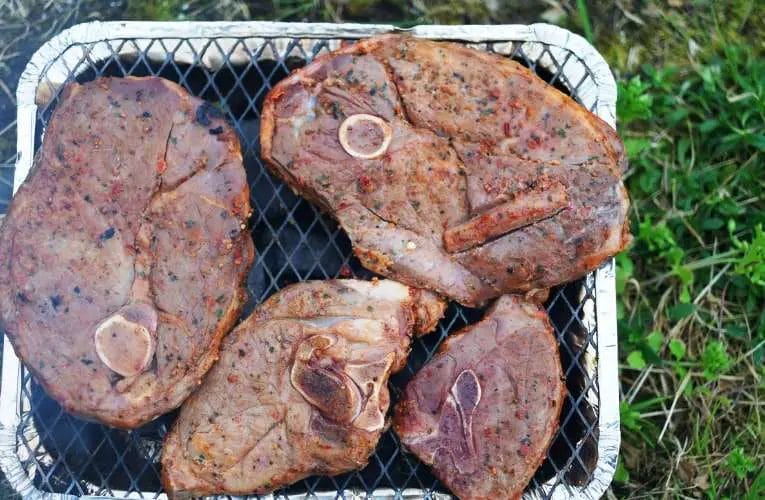
Tips to Tenderize Tough Steak
When it comes to enjoying a delicious steak, tenderness is key. However, not all cuts of steak are naturally tender, and sometimes you may end up with a tougher piece of meat.
But don’t worry, there are several techniques you can use to tenderize tough steak and ensure a melt-in-your-mouth dining experience. In this section, we will explore some tried and tested tips to help you tenderize that stubborn steak.
1. Marinating
Marinating your steak is one of the most effective ways to tenderize it. A marinade typically consists of an acidic ingredient, such as vinegar or citrus juice, along with other flavorings like herbs and spices.
The acidic component helps break down the tough muscle fibers, resulting in a more tender cut of meat. To marinate your steak, simply place it in a sealable plastic bag or a covered container, pour the marinade over it, and let it sit in the refrigerator for a few hours or overnight.
Remember to discard the marinade after use, as it may contain harmful bacteria.
2. Using a Meat Tenderizer
A meat tenderizer, also known as a meat mallet or a meat pounder, can be a handy tool in your kitchen arsenal. It consists of a flat surface with small pointed or textured indentations.
Gently pounding the steak with a meat tenderizer helps break down the connective tissues and tenderize the meat. Start by placing the steak on a cutting board or a sturdy surface and use the tenderizer to lightly pound it on both sides. Be careful not to go overboard and turn the steak into mush.
3. Applying Salt
Another technique to tenderize tough steak is to season it with salt. Salt acts as a natural meat tenderizer by drawing out moisture from the steak, which then gets reabsorbed, breaking down the muscle fibers and making the meat more tender.
To use this method, generously sprinkle salt on both sides of the steak and let it sit at room temperature for about 40 minutes. Afterward, rinse off the excess salt and pat the steak dry before cooking.
4. Using a Meat Mallet
In addition to a meat tenderizer, you can also use a meat mallet to physically tenderize the steak. Unlike a meat tenderizer, a meat mallet has a flat surface with no indentations.
To use a meat mallet, place the steak on a cutting board and use the mallet to gently pound the steak on both sides. This helps to break down the meat fibers and make the steak more tender. Just like with the meat tenderizer, be careful not to overdo it.
5. Slow Cooking
If you have the time and patience, slow cooking is an excellent method for tenderizing tough steak. Slow cooking involves cooking the steak at a low temperature for an extended period, allowing the connective tissues to break down and the meat to become tender.
You can use a slow cooker or braise the steak in a covered pot in the oven. The low and slow cooking process helps transform a tough piece of meat into a succulent and tender delight.
6. Using Enzyme-Based Tenderizers
Enzyme-based tenderizers, such as papain (derived from papaya) or bromelain (found in pineapple), can be used to tenderize tough steak. These enzymes break down the proteins in the meat, making it more tender.
Simply sprinkle or rub the tenderizer onto the steak and let it sit for the recommended time, usually about 30 minutes to an hour. Rinse off the tenderizer before cooking to prevent any unwanted taste.
By following these tips and techniques, you can turn a tough steak into a tender and delicious meal. Experiment with different methods to find the one that works best for you and enjoy a melt-in-your-mouth steak every time!
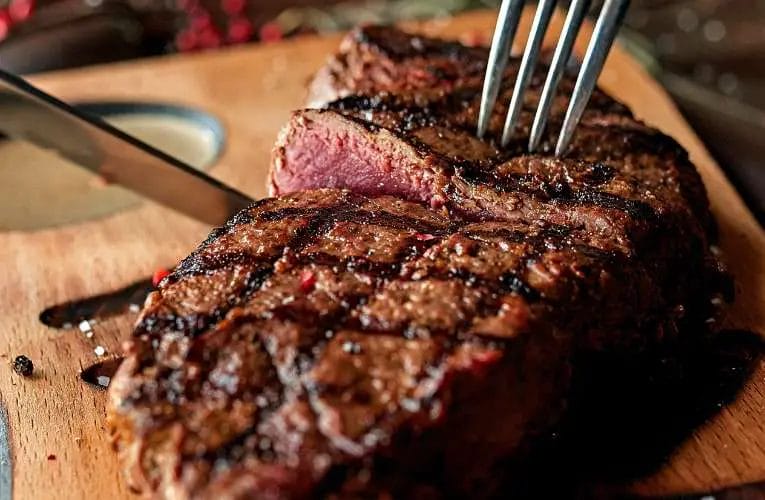
Cooking Techniques to Avoid Tough Steak
Steak is a delicious and indulgent cut of meat that can be enjoyed in various ways. However, if not cooked properly, steak can turn out tough and chewy, ruining the dining experience.
To ensure a tender and juicy steak, it is important to use the right cooking techniques. In this section, we will discuss some common cooking techniques to avoid when preparing steak.
1. Overcooking
One of the biggest mistakes people make when cooking steak is overcooking it. Overcooking can result in a tough and dry steak.
To achieve the desired level of doneness without sacrificing tenderness, it is important to use a meat thermometer to monitor the internal temperature of the steak. Different cuts of steak require different cooking times and temperatures, so it is essential to follow a recipe or cooking guidelines.
2. High Heat for Extended Periods
Cooking steak over high heat for too long can also lead to a tough texture. While searing steak at high heat can create a flavorful crust, it is important to finish cooking the steak at a lower temperature to allow the meat to cook evenly and retain its moisture.
Avoid leaving the steak on high heat for extended periods and instead, opt for a two-step cooking process by searing on high heat and then finishing in the oven or on a lower heat.
3. Skipping the Resting Period
Resting the steak after cooking is a crucial step that should never be skipped. During the cooking process, the heat causes the juices in the steak to move towards the center.
Resting the steak allows the juices to redistribute throughout the meat, resulting in a more tender and flavorful steak. Ideally, the steak should be rested for about 5-10 minutes before slicing and serving.
4. Using a Fork to Flip or Pierce the Steak
Using a fork to flip or pierce the steak while cooking can cause the juices to escape, leading to a drier and tougher steak. Instead, use tongs or a spatula to handle the steak and avoid piercing it with any utensils. This will help retain the natural juices and ensure a moist and tender steak.
5. Not Seasoning Adequately
Proper seasoning is crucial for enhancing the flavor of the steak. Seasoning the steak with salt and pepper before cooking helps to tenderize the meat and bring out its natural flavors.
Make sure to season the steak generously on both sides before cooking. Additionally, you can experiment with various marinades and rubs to add more depth and flavor to your steak.
6. Cutting the Steak Too Early
It can be tempting to cut into the steak immediately after cooking to check if it’s done. However, cutting the steak too early can cause the juices to escape, resulting in a drier and less flavorful steak.
To ensure maximum tenderness and juiciness, allow the steak to rest as mentioned earlier and then cut it against the grain just before serving. This will help in retaining the moisture and tenderness of the steak.
How to Choose Tender Cuts of Steak
Choosing the right cut of steak is essential to ensure a tender and flavorful dining experience. With so many options to choose from, it can be overwhelming to know which cuts are the most tender.
In this section, we will guide you through the process of selecting the perfect tender cuts of steak for your next meal.
Understanding Tender Cuts of Steak
Before diving into the selection process, it is important to understand what makes a cut of steak tender. The tenderness of a steak primarily depends on the muscle it is sourced from and the amount of fat marbling within the meat. Muscles that are less exercised and contain more fat tend to be more tender.
Now let’s explore some of the most popular tender cuts of steak:
1. Filet Mignon
Filet mignon, also known as tenderloin, is renowned for its exceptional tenderness. This cut is sourced from the tenderloin muscle, which is located in the loin section of the beef.
It is incredibly tender due to the limited amount of work this muscle performs. Filet mignon is lean and has a buttery texture, making it a top choice for steak enthusiasts.
2. Ribeye
The ribeye is another highly sought-after cut known for its tenderness and rich flavor. This cut is taken from the rib section of the beef and has excellent marbling, which adds to its juiciness and tenderness.
The ribeye is known for its delicious fat cap, which enhances the taste and juiciness of the meat.
3. New York Strip
The New York strip, also known as the strip steak or sirloin strip, is a popular choice among steak lovers. It is cut from the short loin section of the beef and is recognized for its excellent balance of tenderness and flavor. The New York strip has a moderate amount of marbling and a robust beefy taste.
4. T-Bone and Porterhouse
T-Bone and Porterhouse steaks are two cuts that offer the best of both worlds. They consist of two different muscles—the tenderloin on one side and the strip steak on the other—separated by a T-shaped bone.
These cuts are known for their tenderness, marbling, and versatility. The Porterhouse is larger and contains a larger portion of tenderloin compared to the T-Bone.
5. Sirloin
The sirloin steak is a versatile and flavorful cut that is sourced from the sirloin section of the beef. It offers a good balance between tenderness and beefy flavor. The top sirloin is slightly more tender and well-marbled compared to the bottom sirloin. Sirloin steaks are great for grilling, broiling, or pan-searing.
Choosing the Perfect Steak
When selecting a tender cut of steak, there are a few factors to consider:
- Grade: Look for steaks with a higher grade, such as USDA Prime or USDA Choice, as they are more likely to be tender and flavorful.
- Marbling: Check the marbling within the meat. The presence of fine lines of fat throughout the muscle indicates a more tender steak.
- Color: Choose steaks that have a bright cherry-red color, as this indicates freshness.
- Thickness: Opt for steaks that are at least 1 inch thick, as thicker steaks tend to be more tender and easier to cook to the desired level of doneness.
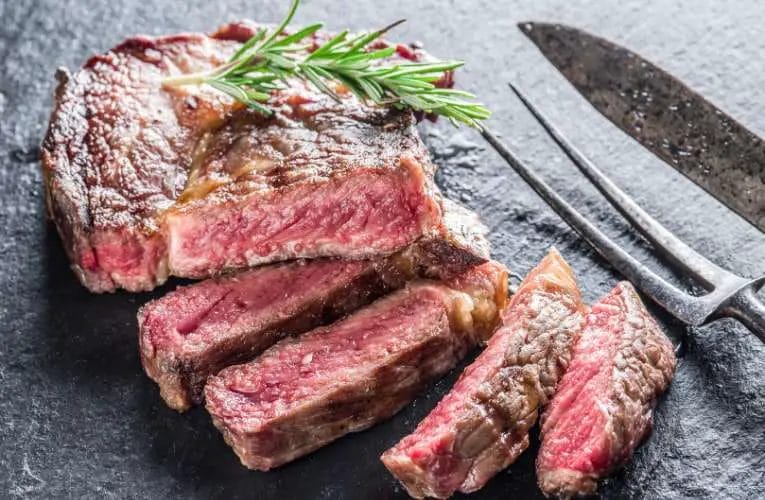
Alternative Cooking Methods for Tough Cuts of Steak
When it comes to cooking steak, many people prefer the tender and juicy cuts. However, there are times when you may find yourself with a tough cut of steak that requires alternative cooking methods to make it enjoyable.
In this section, we will explore some techniques that can transform tough cuts of steak into a delicious and tender meal.
1. Marinating
Marinating is a simple and effective way to tenderize tough cuts of steak. By soaking the steak in a flavorful marinade, you can break down the tough muscle fibers and infuse it with delicious flavors.
To marinate a tough cut of steak, prepare a marinade using ingredients such as soy sauce, vinegar, citrus juice, herbs, and spices. Place the steak in the marinade and let it sit in the refrigerator for at least a few hours, or preferably overnight.
When you’re ready to cook, remove the steak from the marinade and cook it using your preferred method, such as grilling or pan-searing.
2. Slow Cooking
Slow cooking is another great option for tough cuts of steak. This method involves cooking the steak at a low temperature over a long period of time, which helps to break down the tough connective tissues and collagen, resulting in a tender and flavorful steak.
You can use a slow cooker or a Dutch oven for this cooking method. Simply season the steak with salt, pepper, and any other desired spices, then place it in the slow cooker or Dutch oven along with some liquid, such as broth or wine. Cook on low heat for several hours until the steak is fork-tender.
3. Braising
Braising is a technique that involves searing the steak first to develop a flavorful crust, and then simmering it in a liquid until it becomes tender. This method is perfect for tough cuts of steak as it helps to break down the tough fibers and infuse the meat with rich flavors.
To braise a tough cut of steak, start by searing it in a hot pan with some oil until it develops a nice brown crust. Then, transfer the steak to a pot and add in some liquid such as beef broth, wine, or a combination of both. Cover the pot and simmer the steak on low heat until it becomes tender.
4. Tenderizing
If you’re looking for a quick and easy method to tenderize tough cuts of steak, consider using a meat tenderizer. This tool has small blades or spikes that penetrate the meat, breaking down the tough muscle fibers and making it more tender.
Simply place the tough cut of steak on a cutting board, and use the meat tenderizer to gently pound the meat. Be sure to pound evenly and avoid over-tenderizing the steak, as it can result in a mushy texture.
Once tenderized, you can cook the steak using your preferred method, such as grilling or pan-searing.
5. Sous Vide
Sous vide is a cooking method that involves vacuum-sealing the steak and cooking it in a water bath at a precise temperature. This gentle and controlled cooking process ensures that the steak is cooked evenly and becomes tender throughout.
To cook a tough cut of steak using sous vide, season the steak with salt, pepper, and any desired spices. Place it in a vacuum-sealed bag, removing as much air as possible.
Submerge the bag in a preheated water bath and cook at the recommended temperature for the desired doneness. Once cooked, sear the steak briefly in a hot pan to develop a flavorful crust.
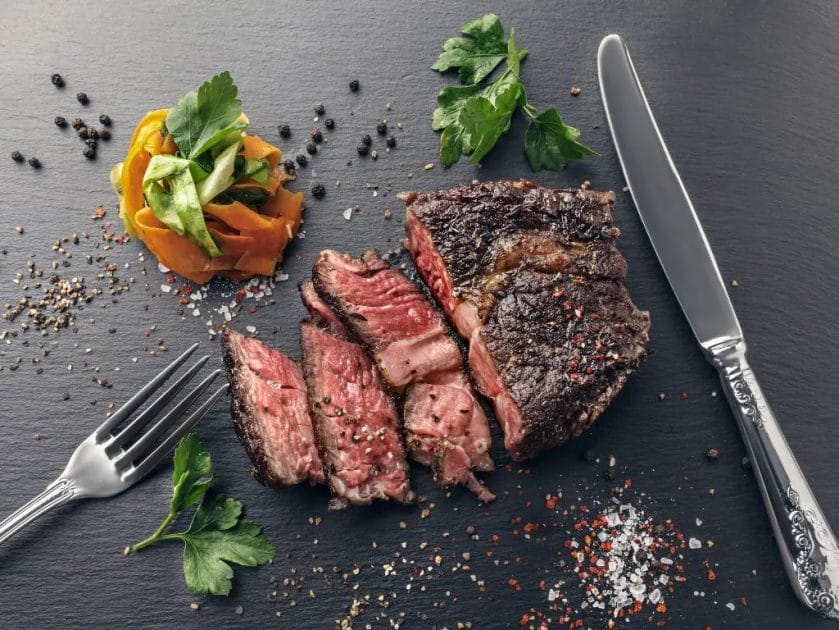
FAQs
Why is my steak tough?
There are a few possible reasons why your steak might be tough. One reason could be that it was cooked for too long, causing the meat to become overcooked and lose moisture.
Another reason could be that it was not properly tenderized before cooking. Lastly, the toughness could be due to the cut of meat being too lean or lacking marbling.
Conclusion
In conclusion, if you’re wondering why your steak is tough, there can be several factors at play. Cooking duration and temperature are crucial in achieving the desired tenderness. It’s important to cook the steak to the proper internal temperature for the desired level of doneness.
Additionally, the cut of meat and its quality can greatly impact the tenderness. Choosing a well-marbled and properly aged steak can make a significant difference in texture. Lastly, the way the steak is handled before cooking, such as marinating or tenderizing, can also influence its tenderness.
By considering these factors and employing the right cooking techniques, you can enjoy a perfectly tender and delicious steak every time.

